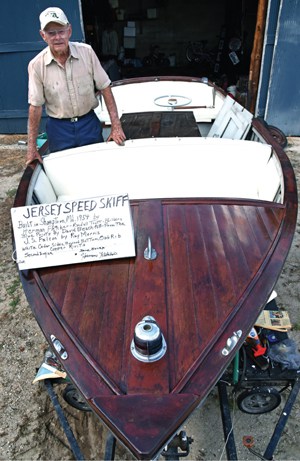It’s dusty after sitting in a farm shed near Sharptown, Md., for the past two decades, but the speedboat still sparkles when Herman Fletcher, 91, looks at it. It’s his pride and joy.
“I wanted a boat but couldn’t afford one in 1952,” Fletcher said. “So one morning my friend Merrel Bowman and I went down the Nanticoke River, cut five cypress trees and floated them back to Sharptown. I loaded them up and took them to the sawmill.”
After they were seasoned, farmer Fletcher and another friend, Randall Truitt, got to work building a Jersey Speed Skiff, in the mostly unlikely of places—the second floor of Fletcher’s old potato house.
A wood stove on the first floor gave off enough heat to protect the potatoes that were in storage, and just enough warm air drifted to the second floor to keep the men comfortable as they worked through the winter.
Fletcher had already made a couple of traditional Nanticoke River shad barge-style boats, using common sense and advice from local fishermen, but tackling a sleek and elegant speedboat required actual blueprints that he found in a magazine. After all, this was going to be the then-27-year-old’s dreamboat. “It was a major undertaking,” he said.
“Everybody who came to see us build it, asked the same question, ‘How are you goin’ to get it out of the loft?’ There’s a door up there, and the boat was only 36 inches wide when we turned it on its side, so it fit through,” Fletcher said.
“We took it down just two days before Hurricane Hazel hit in 1954. We had it on a flatbed wagon, and we were afraid it was goin’ to blow away, so we put it in a shed. The hurricane blew down every building we had on the farm, even the cow barn, but the shed where the boat was stored was okay.”
For the bottom, Fletcher had managed to recycle a piece of 3/ 4-inch marine grade plywood from a yard in Baltimore that was building PT boats. He steamed white oak pieces and bent them to shape for the ribs.
“I finished it up in 1955,” Fletcher said. He named it Cherub.
“Randall wanted me to get an engine right away, but I didn’t have money enough. Times were tight,” he said, laughing. “But I got hold of some money and bought a new six-cylinder 261 Chevrolet engine and a Joe’s transmission.”
The new transmission was a second, and Fletcher discovered multiple problems getting it to operate. One day, he dropped a screw into it and had to take it apart to retrieve it. “I got the screw out and discovered the parts weren’t put together right on the inside, so I rebuilt it right. Worked fine after that. I put a lot of hours on that thing.”
He smiles with pride recalling days cruising along the Nanticoke River with just enough power to get the bow to rise gracefully out of the water.
“At that time there was only one other Jersey Skiff built on the Eastern Shore, and it was in Cambridge, owned by attorney Ed Nabb,” he said. Fletcher competed several times in the Cambridge Classic Boat Race. “Cherub would only do about 55- to 57-miles per hour. I never won, but I sure had fun,” he said.
When not cruising in style, Fletcher took his boat to the mouth of the river and used a 100-foot trotline to catch a few dozen crabs on lazy summer days.

As the years passed, farming demanded more and more of his time, and the boat remained in the shed, on the trailer, ready to go if a precious free day came up. It didn’t, and the tarp that covered it got so old it rotted.
There were times when Fletcher could have gone boating, but working on his 1926 Model T Ford Roadster, getting it ready for numerous shows, came first.
This summer he got a new license for his boat, replacing the one that expired in 1997. “I put a new coat of paint on it, and have been meaning to put it overboard, but it’s been too darn hot. When it cools down, I’ll be back on the water.”
—Brice Stump



